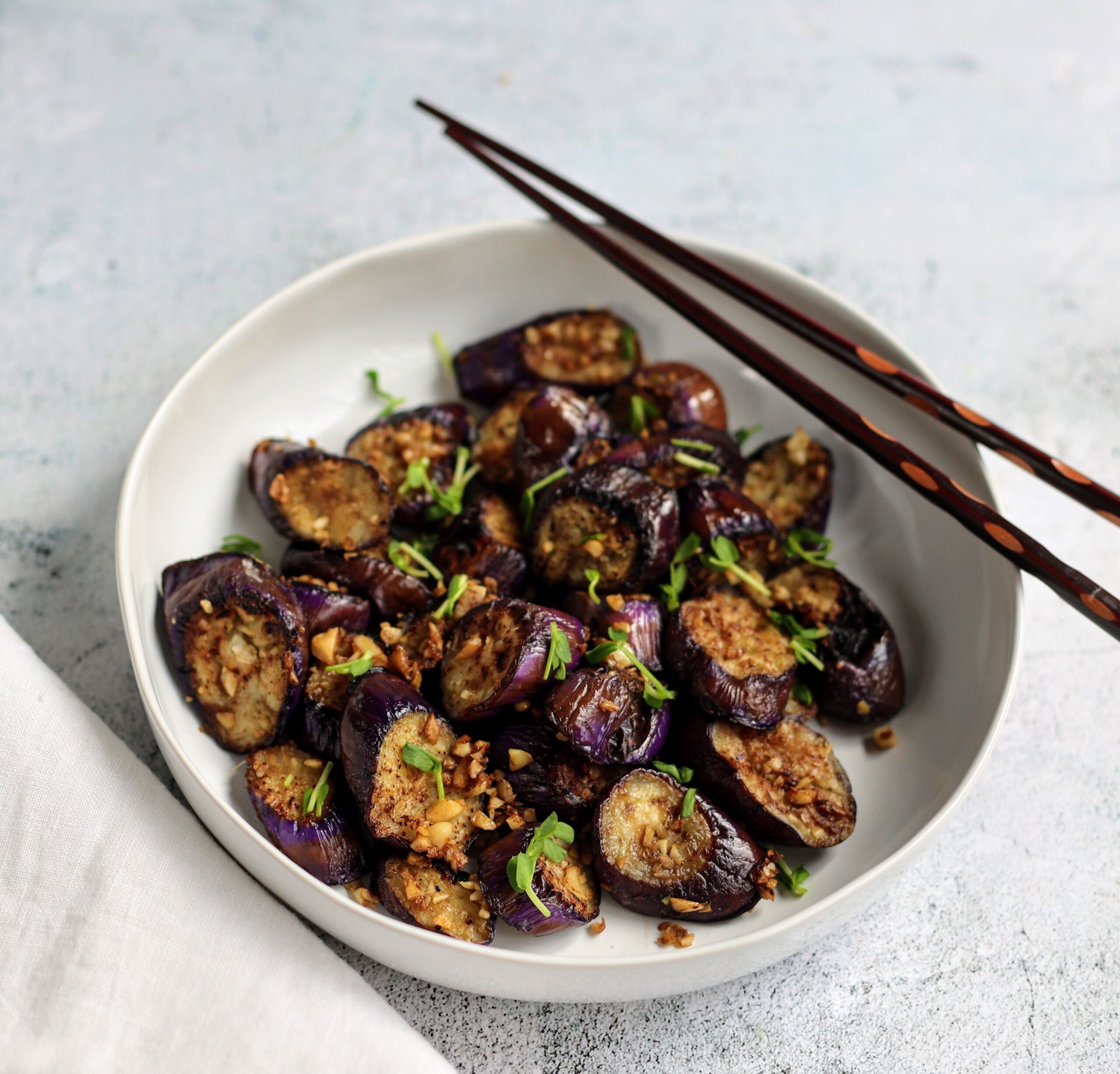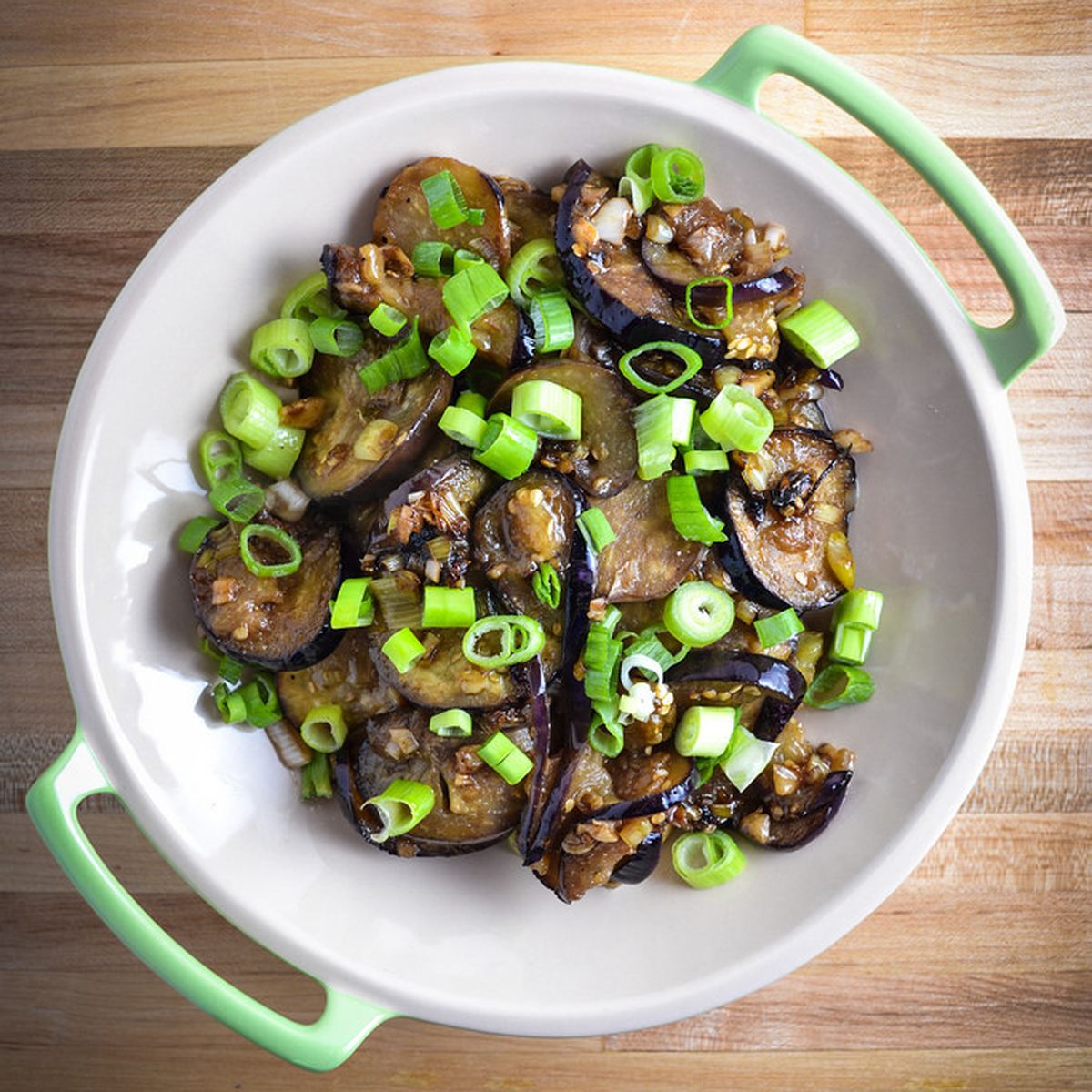
Stir-fried Japanese Eggplant with Garlic and Ginger

Stir-frying Japanese eggplant with lots of garlic, fresh ginger, and soy sauce is one of my favorite Asian dishes. So simple, yet packed with flavor and texture. I am a big fan of the long slender Japanese (also called Chinese) eggplant. They are less bitter and have a slightly sweeter taste than their Italian counterpart, and because they have a thin skin, and sponge-like flesh, they quickly absorb flavors. Plus, there’s no need to peel or salt them ahead of time — a real bonus in my book!
Prep: 10min
Total: 20min
Yield: 4
Serving Size: 1 serving
Nutrition Facts: servingSize 1 serving, calories 163 kcal, Sugar 6.1 g, Sodium 4.6 mg, Fat 17.3 g, Carbohydrate 13.4 g, Protein 2 g
Ingredients:
- 1 1/2 to 2 pounds Japanese or Chinese eggplant
- 4 – 6 Tablespoons cornstarch
- 3 Tablespoons peanut or vegetable oil (plus more as needed)
- 2 Tablespoons Asian (toasted sesame oil)
- 5 cloves garlic (minced)
- 1 Tablespoon minced fresh ginger
- 2 Tablespoons low-sodium soy sauce (plus more as needed)
- Sliced scallions or microgreens (for garnish)
Instruction:
- Slice the eggplant on the diagonal 3/4 to 1 inch thick, larger pieces cut in half lengthwise. Transfer the eggplant slices to a medium bowl, sprinkle with the cornstarch, and toss to coat evenly. Heat the oil in a 12-inch skillet or wok over medium-high heat. Add just enough eggplant to create a single layer so that no slices overlap. Cook, flipping once, until the eggplant is golden and a bit charred in places, 2-1/2 to 3 minutes total. Transfer the eggplant to a paper-towel-lined rimmed baking sheet. Repeat with the remaining eggplant, adding more oil to the pan as needed.
- Wipe the pan clean, then add the sesame oil over low heat. Add the garlic and ginger, and cook, stirring, until fragrant, about 20 seconds. Return the eggplant to the pan. Add the soy sauce, and toss to combine, about 1 minute. Serve topped with the scallion, and season to taste with more soy sauce.
Japanese Eggplant With Ginger & Scallions

This Japanese eggplant recipe is made with ginger, scallions, and a slightly spicy sauce. Perfect for when you need a side dish that can be made in 30 minutes.
Prep: 15min
Yield: Serves 4
Ingredients:
- 2 tablespoons canola oil
- 1 to 2 jalapeños, chopped
- 3 garlic cloves, finely chopped
- 2 tablespoons peeled finely chopped ginger
- 3 large scallions, chopped, green and white parts separated
- 1 1/2 pounds Japanese eggplant, sliced into thin rounds
- 4 tablespoons rice wine vinegar
- 3 tablespoons soy sauce
- 1 tablespoon cornstarch
- 1 tablespoon sugar
Instruction:
- [{‘@type’: ‘HowToStep’, ‘text’: ‘In a large skillet over medium-high heat, heat the oil. Add the jalapeños, garlic, ginger, and white scallion parts and cook, stirring, for 2 to 3 minutes, until fragrant.’}, {‘@type’: ‘HowToStep’, ‘text’: ‘Stir in the eggplant and cook, tossing occasionally, for about 5 minutes, until the eggplant has softened.’}, {‘@type’: ‘HowToStep’, ‘text’: ‘Meanwhile, in a small bowl, combine the vinegar, soy sauce, cornstarch, and sugar. Once eggplants have softened, pour the sauce into the pan and bring to a boil, stirring to coat. Reduce the heat to medium-low and cook for 5 to 6 minutes, until the sauce has thickened.’}, {‘@type’: ‘HowToStep’, ‘text’: ‘Remove from the heat. Top with the green scallion parts. Transfer to a platter or divide among plates’}]
Miso Glazed Eggplant – Japanese Nasu Dengaku Recipe
FAQ
Does Japanese eggplant need to be peeled?
What is the difference between Japanese eggplant and regular eggplant?
What is Japanese eggplant good for?
Why do you soak eggplant in water before cooking?
